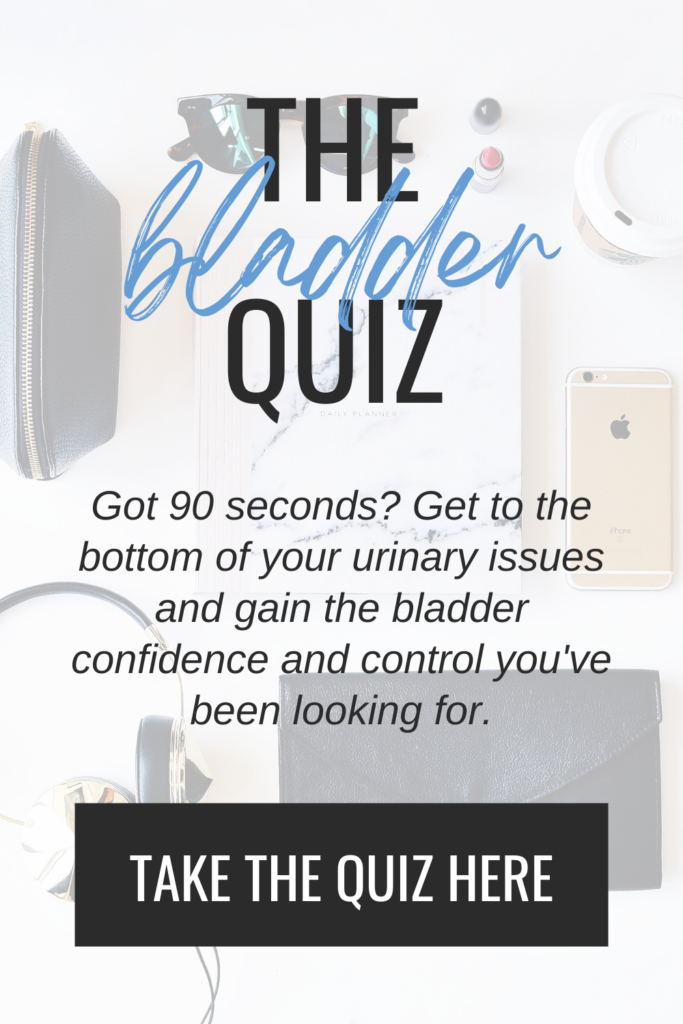Praise the good Lord above, the conversation and awareness around pelvic health is becoming quite popular these days. (Maybe not as trendy as green drinks or infrared saunas, but we’re getting’ there!) And while working with a pelvic floor physical therapist is theeeeee best option to quickly and effectively heal bowel and bladder issues, pelvic pain, and sexual dysfunction, I 1000000% understand not everyone has the bandwidth or bankroll to make that happen.
That’s why I created Make + Manifest – the blog posts, online courses, and virtual consults: to bring the pelvic health benefits out of the clinic and onto the world wide web; to educate, empower, and ultimately impact more women than I could ever reach during a 40-hour work week in my small town across the water from Seattle. Nothing beats a personalized experience with a pelvic rehab specialist, but there are so many simple, DIY-abe steps with real life results available…and oooooooh I want them in your hands, friend!
Pelvic health isn’t rocket science. Yes, there’s A LOT going on in this area of the body, but addressing its issues often only requires a little more awareness of anatomy and proactively applying that knowledge throughout your day. No fancy equipment, hours of exercises, or voodoo mama joojooo needed!
RELATED POST: Easy & Impactful Ways to Use Your Time Confetti to Improve Your Pelvic Floor Health
RELATED POST: No Time? Car-Friendly Pelvic Floor Exercises You Can Complete on Your Morning Commute
RELATED POST: How to Make Time For Your Health Among the Hustle
Tangible, lasting change should ~always~ be the goal when it comes to pelvic health, and I’m not gonna lie – that takes time, consistency, and hardest of all…patience. But I’m all for a few quick wins right off the bat to get the motivation movin’ & momentum goin’ in the right direction (and when I say quick, I mean same week, same day, even same hour kinda stuff, m’kay?!). So keep reading for my roundup of the ten simple, shortcut-esque strategies you can implement right now for fast pelvic health success.
Two things before we get started…
1. In the name of keeping things snappy, I’ve made the explanations of each pelvic health shortcut…well…short and sweet. I figured there’s no reason to complicate things here. If you find yourself wanting more and need to dive deeper into any of the topics, please refer to the “related posts” or linked resources for further information and guidance. I’ve got you, girl.
2. Do not, I repeat…DO NOT attempt to implement all ten strategies right away. Pick the one or two that resonate with you, that your intuition perks up to, and perfect it. Only once you’re consistent, comfortable, and confident (and maybe even seeing those results *wink wink*) should you head back here to tackle your next to-do.
Now for those simple pelvic health shortcuts!
If your excuse (*ahem*…sorry) reason for not committing to your pelvic health until today sounds a little like “not enough time”, “don’t know where to start”, or “just too dang complicated”, then you’re 100000000% in the right place and I can’t wait for you to get started. I firmly believe addressing bladder, bowel, and sexual issues doesn’t need to be expensive, complicated, or time-consuming, and these shortcuts are proof. Let’s get to it!
1. POSTURE, POSTURE, POSTURE
If you too hear your mom’s voice every time you think of posture, you’re not alone. And if you’re also at the age where you’re realizing she was always right, then this one mayyyyyy not surprise you. Posture dictates pelvic floor muscle length and position, and how you sit and stand through the day can cause muscle tightness (not a good thing, btw), weakness, and pain, and therefore affect how the pelvic floor feels and functions.
RELATED POST: 5 Reasons Kegels Aren’t Working For You
But fear not…posture perfection isn’t necessary or expected; simply improving your awareness around it is all it takes to see results. Try setting a cue through your day (like every time you get a text, check the clock, walk into the kitchen, or hear the word “mooooooom”) that reminds you to check in and correct your posture regularly. PS, this takes two seconds. Aim for a “neutral” or “even” pelvis – not tilted too far forward or back, nor always leaning to one side – to place your pelvic floor in its happiest, healthiest position.
2. STOP DOING KEGELS
Yep, you read that right! While Youtube or TikTok might tell you otherwise, I’m here to set the record straight. The average woman has a tight pelvic floor (again…not a good thing), which leads to muscle pain and dysfunction – aka every bladder, bowel, and sexual concern you could possibly think of. And just like you wouldn’t give a stress ball to someone whose hand is stuck in a fist, regular and repetitive kegels will only make pelvic floor tension worse.
RELATED POST: 19 Reasons Your Pelvic Floor Is Too Tight (Plus…What to Do About It
Instead of kegels, the ~exact~ opposite is the best place to start healing your pelvic floor. Learning to release or relax these muscles first is key for their mobility, strength, coordination, and control. While the above point on posture will start this process, there are a few other fit-into-your-life-seamlessly strategies that promote pelvic floor relaxation. For those how-to’s, peep the related posts below or simply grab my most popular free guide here to begin relaxing your pelvic floor muscles today.
RELATED POST: My Daily Pelvic Floor Relaxation Routine & Why You Might Wanna Try It Too
3. THE KNACK
We just established that repetitive kegels aren’t ideal for most, but if you have stress incontinence (urine leakage with coughing, laughing, sneezing, etc), pelvic organ prolapse (when the bladder, uterus, and/or rectum are descending into the vaginal canal), or want to prevent both, there’s one specific instance that kegels are helpful. Pressure on the pelvic floor in the presence of weak and uncoordinated muscles causes stress incontinence and prolapse. There’s a way to resist that pressure and improve pelvic floor strength and coordination in the process, and it’s called “the knack”.
How to do “the knack” –
1. Right before doing an activity that places pressure on the pelvic floor – coughing, laughing, sneezing lifting, bending, pushing, pulling, squatting – perform a quick and strong kegel to brace your pelvic floor.
2. Hold the kegel through the activity.
3. Release the kegel once you’re done with the activity.
4. Please note – “the knack” does not work and should not be done with prolonged movements like running or jumping rope.
4. ONLY GO WHEN YOU GOTTA GO
The quick restroom trip “just in case” before you head out the door…or board the plane…or leave the store…or watch the movie…is called “JIC-ing” in pelvic rehab world (which stands for “just in case-ing”) and it’s aaaaaactually not the best thing for your bladder. In fact, regularly peeing before having the urge promotes bad bladder habits and will eventually initiate and exacerbate urinary urgency and frequency.
RELATED POST: Urinary Urgency & Frequency? You’ve Gotta Stop Making These 5 [Big] Bladder Mistakes
So don’t be afraid to hold it (we’re given that ability for a reason). Force your bladder to fill (there’s rarely such a thing as a small bladder, so it’s very likely yours can hold about 600 mL or the equivalent of a venti coffee). And only go when you really, truly gotta go. “JIC-ing” won’t prevent urine leakage, and now you know it won’t help urgency or frequency in the long run either. If you’re dealing with any of the above and ultimately desire a bladder that can keep up with your busy & beautiful life, The Bladder Blueprint is my signature online course and the A-Z roadmap you’ve been looking for.
5. NO MORE SOAP
Unfortunately the vagina doesn’t come with a user manual, so many of us are just doing what our moms told us, we heard from girlfriends, or randomly learned in health class. And no offense to anyone on that list, but when it comes to cleaning your vulva (the genitals, or outer area of the vagina) and vaginal canal, they likely it wrong. The vulva and vagina are self-cleaning structures and adding soap to your hygiene routine “down there” kills the body’s good bacteria, alters your pH levels, and can cause skin irritation & pelvic floor muscle tension.
Literally nothing is necessary to clean the vaginal canal (inside the hole)…just leave that one up to your body. To properly wash the vulva, all you need is water and your hand. Simply fill your hand with warm water and splash it around the labia majora (where the hair grows), labia minora (also called “the lips”), and clitoris, or set your removable shower head on the most gentle setting and spray. For a deeper dive into vaginal & vulvar care, check out that related post below or snag my free guide all about it here.
RELATED POST: The 411 on Pubic Hair & Your Ultimate Guide to Care for “Down There”
6. REST IN THE RESTROOM
We’re all guilty of going to the bathroom “real quick”, but rushing your time on the toilet could be the cause of those annoying bowel and bladder issues – constipation, leakage, urgency, and frequency, fecal staining (skid marks), or post-urinary dribble (that little bit of leakage once you stand up from the toilet). Bladder and bowel function require a series of reflexes in the body to properly start and finish, and gosh dang it, those things can’t be rushed!
Simply taking your time and actually resting in the RESTroom (I’m talkin’ two minutes here…max!), can often be the quick fix many people need to see results. Use those two minutes to put your phone down, take a few breaths, relax your jaw, shoulders, and pelvic floor, even say a few positive affirmations if you’re feelin’ feisty. Life is busy, so use this time as the mini break your body and brain deserve.
7. HYDRATE
In my humble opinion, drinking water is one of the cheapest, easiest, most accessible things we can do for our body’s overall health, and pelvic health most definitely falls in that category too. From relieving constipation to improving natural vaginal lubrication, optimizing bladder function, and resolving period cramps, there’s really nothing a good ol’ glass of water can’t do. But just like most things in life, there’s a right way to do it for optimal results.
A few helpful water drinking tips –
- Drink half of your body weight (in pounds) in ounces of water. For example, if someone weighs 150 pounds, she should be drinking around 75 ounces of water per day.
- Consume two thirds of your body weight (in pounds) in ounces of water if you’re pregnant, breastfeeding, living at higher altitudes, in warmer climates, or exercise vigorously regularly.
- If you do the math and find you’re not drinking enough, don’t jump to your new water goals tomorrow. Slowly increase by about ten ounces per week until you reach your target amount.
- Drink steadily and regularly through the day, limiting the need to take in large quantities at once. Five to ten ounces per waking hour adds up to the goal amount for most.
- Plain ol’ H2O should account for two thirds of your daily water intake. The other third can include coffee, tea, kombucha, sparkling water, and even juice.
RELATED POST: Read [THIS] If Coffee Irritates Your Bladder
8. BOOTY GAINZZZZZ
If you too can recite every word of Sir Mix-a-Lot’s “Baby Got Back”, then you likely don’t need another excuse to work on your booty strength. But just in case that’s not enough motivation, keep in mind that strong glute and hip muscles carry over to the pelvic floor and can help with urine leakage, pelvic organ prolapse, back and hip pain, postpartum recovery, and more.
But here’s the kicker…the glute and hip exercises that act as a pelvic health shortcut include hip rotation and lateral (or side-to-side) movements – things we don’t necessarily or naturally do in our everyday. So these muscles don’t necessarily get stronger by going on walks, playing with your kids, cleaning the house, or being active at work (aka – you have to put extra intention into this one). But fifteen minutes a few days a week doing my favorite glute & hip strengthening exercises is all you need to start seeing results.
9. SQUATTY POTTY
There’s a reason people used to (and sometimes still do) squat to poop, and it’s not only based on if there’s a toilet available. The squatted position allows for easer bowel movements by increasing the angle between the rectum and anus, relaxing the pelvic floor, and un-kinking the colon. If you experience constipation or difficulty passing bowel movements, [this] is the easiest thing to try before looking into the more complicated culprits like diet, hormones, and medication side-effects.
RELATED POST: 13 [Effective] Strategies for Natural Constipation Relief
In order to get the same squatting effect on a toilet, try this – Sit with your feet on a squatty potty or stool that’s tall enough to place your knees higher than your hips. Keeping a straight back, lean slightly forward and rest your elbows on your knees. Take your time (see pelvic health shortcut #6), relax your pelvic floor (that’s shortcut #2) and watch the magic happen.
10. BE AWARE OF STRESS
I saved the hardest, most ambiguous, a little bit woo woo one for last, but stay with me here. While the “stress less” guidance is an easier said than done kinda thing, the benefits of reducing anxiety, tension, fear, and overwhelm in your life can have a surprisingly positive effect on the pelvic floor. Stress is a primary culprit of bladder, bowel, and sexual complaints – from a physiological change in hormones to pelvic floor muscle tension – and finding ways to mange and ultimately reduce it are huge for pelvic health.
RELATED POST: 3 [Shocking] Ways Your Pelvic Floor Responds to Stress
RELATED POST: Mantras, Meditation, & 14 Other Kiiiiiiinda Crunchy Practices for Stress Relief
Unfortunately there’s no quick fix for less stress. The post above shares a few of my favorite techniques for stress relief, but let’s be honest…there will always be things that make life a little rough sometimes, no matter what essential oils you diffuse or mantras you repeat in the mirror. When it comes to pelvic health, the best shortcut is to be mindful of stress and aware of pelvic floor symptoms worsening in those tougher times. This simple realization alone can significantly change your attitude towards your pelvic health and the amount of grace you give yourself.
You now have my best pelvic health shortcuts…promise
Just like most things in life, there’s no all-in-one pill, revolutionary machine, state of the art procedure, orrrrrrr magic wand that will instantly resolve your pelvic health issues overnight (if I ever hear of one, you’ll be the first to know…promise). But with a little mindfulness, dash of proactivity, and ounce of time you can begin to fix your pelvic floor concerns relatively quickly with the shortcuts above.
I would call some of these my “best kept secrets”, but there are ZERO secrets here, friend. There’s nothing I want more than for you to have access to the things that work, the things that cut the fluff, ditch overwhelm, and result in attainable, actionable, and accessible pelvic health for each and every woman, her mom, her daughter, her besties, workout buddies, and coworkers.
So would you pass these pelvic health shortcuts along!? Share this post on Pinterest, DM it on Instagram, send the link in text or email or any other ways the cool kids are communicating these days. [This] is the kinda stuff every woman should know.
– Amanda
Disclaimer: The content provided here does not constitute medical advice, nor is it a substitute for personalized healthcare. I’m a doctor, but I’m not your doctor. If you have concerns about a medical condition, diagnosis, or treatment, you should consult with a licensed healthcare professional.
Disclosure: Some of the links above are affiliate links, meaning, at no additional cost to you, I will earn a commission if you click through and make a purchase. No pressure, but I have a feeling you’re gonna like what I’ve taken the time to put my recommendation behind.



















